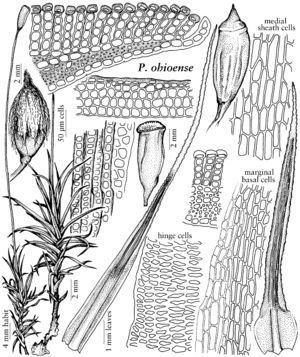Polytrichastrum
Mem. New York Bot. Gard. 21(3): 35. 1971· [Genus Polytrichum and Latin -astrum, incomplete resemblance],.
| Taxon | Illustrator ⠉ | |
|---|---|---|
 | Polytrichastrum alpinum var. sylvaticum | Patricia M. Eckel |
 | Polytrichastrum ohioense | Patricia M. Eckel |
 | Polytrichastrum pallidisetum | Patricia M. Eckel |
Plants polytrichoid, medium-sized to robust, in loose tufts. Stems simple to sparingly (or fasciculately) branched, arising from a short underground rhizome. Leaves with ± differentiated sheathing base and divergent blade; sheath entire, hyaline-margined, often nitid, ± abruptly contracted to the blade, the shoulders with well-developed hinge-tissue; marginal lamina sharply toothed to entire; costa typically short-excurrent or (in perichaetial leaves) prolonged into a toothed awn, rarely the apex cucullate; lamellae numerous, closely spaced, occupying most of the distal surface of the blade, the margins ± entire, finely serrulate or crenulate in profile, smooth or coarsely papillose, the marginal cells in section undifferentiated or sharply distinct. Sexual condition dioicous or polygamous. Seta solitary. Capsule terete or more commonly 4–6-angled, the hypophysis tapering or distinct and cylindric but not sharply delimited; exothecium smooth, the cells not bulging or papillose, not pitted, sometimes with a diffuse thin spot on the outer wall; stomata numerous; operculum rostrate with a distinct beak; peristome not deeply pigmented, the teeth regularly 64, or somewhat fewer and irregular with some teeth compound, not keeled at back; epiphragm with erect toothlike processes opposite the peristome teeth and loosely attached to their inner face. Calyptra cucullate, hidden by an interwoven mat of hairs covering the distal portion of capsule. Spores finely papillose.
Distribution
Widespread in temperate and boreal latitudes in Northern Hemisphere, scattered in the Southern Hemisphere
Discussion
Species ca. 20 (8 in the flora).
Species of Polytrichastrum have a peristome of the leiodont type (S. O. Lindberg 1868). The capsule is terete or obtusely (in fresh capsules) 4–6-angled, the apophysis tapering or short-cylindric but not sharply separated from the rest of the capsule by a deep basal constriction. The epiphragm is loosely attached and early deciduous. Capsules are pale greenish or yellowish brown rather than dark brown or purplish, and not glaucous when fresh as in Polytrichum. The exothecial cells are not bulging mammillose or pitted, but may have a diffuse thin spot on the outer wall. Spores are papillose rather than minutely echinulate as in Polytrichum. Polytrichastrum alpinum is distinct genetically from other members of the genus (G. S. Derda et al. 1999). Other Polytrichastrum species show evidence of allopolyploid origin, possibly involving interspecific or even intergeneric hybridization between species of Polytrichastrum and Polytrichum.
Selected References
Lower Taxa
Key
| 1 | Lamellae coarsely papillose; capsules terete, long-cylindric to ovate-cylindric to suborbicular | > 2 |
| 1 | Lamellae not papillose (rarely faintly striate-papillose); capsules 4-6-angled | > 3 |
| 2 | Lamellae margins entire in profile; exothecial cells without thin spot. | Polytrichastrum alpinum |
| 2 | Lamellae margins crenate in profile, the marginal cells crowned by a papillose knob; [exothecial cells with thin spots]. | Polytrichastrum papillatum |
| 3 | Lamellae crenulate in profile | > 4 |
| 3 | Lamellae entire in profile | > 5 |
| 4 | Marginal cells of lamellae in section narrow, pyriform, thickened in the narrowed apex | Polytrichastrum appalachianum |
| 4 | Marginal cells of lamellae in section wider than those beneath, flat-topped or shallowly retuse. | Polytrichastrum pallidisetum |
| 5 | Marginal lamina entire or obscurely denticulate, inflexed; leaf apex cucullate, rarely bluntly mucronate. | Polytrichastrum sexangulare |
| 5 | Marginal lamina toothed, plane or erect, not inflexed; leaf apex ending in a short awn | > 6 |
| 6 | Marginal cells of lamellae in section wider than those beneath, transversely elliptic, the free wall conspicuously thickened, often brownish. | Polytrichastrum ohioense |
| 6 | Marginal cells of lamellae ovate to elliptic, usually slightly taller than wide, not or evenly thickened | > 7 |
| 7 | Marginal lamina 5-9(-20) cells wide, somewhat incurved when dry; median sheath cells rectangular (3-5:1). | Polytrichastrum longisetum |
| 7 | Marginal lamina 2-5 cells wide, ± erect; median sheath cells elongate (5-9:1) | Polytrichastrum formosum |
"broadened" is not a number.